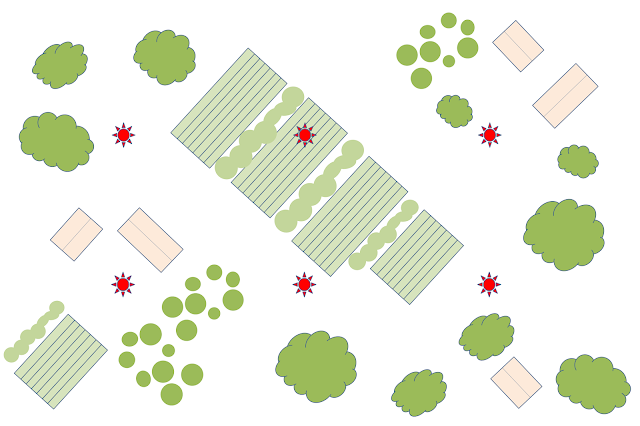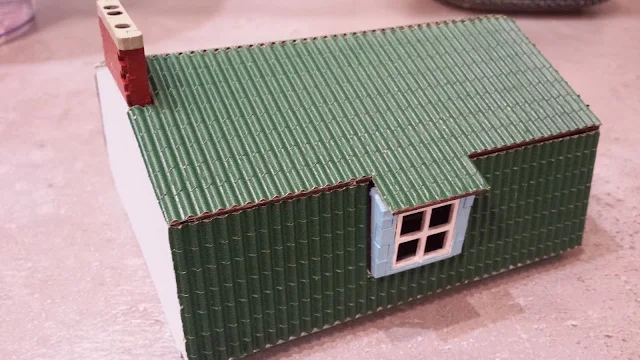English summary: This time roofworks effects using different kind of paper. Roof felt made of black cardboard soaked with diluted PVA and roof tiles of corrugated paper.
Za każdym razem gdy kupuję domki z
Black Grom Studio myślę sobie: co ja położę na dach? Wielką zaletą produktów projektowanych przez Gonza jest cena ale ma to konsekwencje w ilości dostępnych szczegółów. Dachy domków są gładziutkie. Początkowo malowałem dachy po całości kolorem rudym imitującym barwę wypalanej ceramiki. Rozwiązanie to od biedy wystarczyło. Z większej odległości domek wyglądał jak domek pokryty dachówką. Efekt był jednak mizerny gdy spojrzało się na domek z bliska. Jak urozmaicić posiadane dachy ...?
Tematyka dekarska nie dawała mi spokoju. Kolejne domki z Black Grom Studio nie mogły mieć wciąż takiego samego rudego pokrycia. Potrzeba było czegoś nowego. Pomysłem podzielił się Gonzo sprzedając mi technologię kładzenia papy. Papa wykonana z wymoczonego w mocno rozcieńczonym wikolu czarnego kartonu była nakładana z lekkimi nakładkami dając całkiem ciekawy efekt.
Papa nieźle spisuje się również w zabudowie miejskiej zwłaszcza gdy domki stoją w większym
zagęszczeniu i daje pewne urozmaicenie. Wciąż jednak szukałem rozwiązania, które da mi efekt dachówki ceramicznej...
Efekt trójwymiaru jaki mi się marzył próbowałem osiągnąć z użyciem cienkiego styroduru nacinanego w poprzek i naklejanego pasami wzdłuż krawędzi dachu. Efekt przypominał jednak bardziej gont niż dachówkę.
I wtedy Gonzo wrzucił pomysł z
tekturą falistą., którą stosował jako eternit. Malowanie w szarościach z niebieskawym odcieniem rzeczywiście dało efekt takiego rodzaju pokrycia.
Ja jednak oczyma wyobraźni widziałem w tekturze falistej ogromny potencjał, raz blachy falistej raz dachówki ceramicznej. Przystąpiłem więc raźno do testów.
Na pierwszy ogień poszedł prosty dach dwuspadowy. Po pokryciu kolorem bazowym, washem i wytarciu drybrushem uzyskałem efekt jak powyżej. W mojej opinii wygląda znacznie lepiej niż malowanie całej połaci na rudo. Jednak gdyby nie ceglasty kolor można uznać pokrycie za blachę falistą a nie dachówkę. Potrzebowałem wyraźniejszych linii poziomych, które symulowałyby cienie od kolejnych rzędów dachówek.
Drugi testowy dach został - oprócz powyższej procedury przybigowany przed malowaniem tępym nożem. Z daleka efekt wydaje się całkiem dobry. Widać poziome linie rzędów dachówek. To co mnie jednak niepokoiło to efekt ugięcia fal dachówki. Zastosowane rozwiązanie należało jeszcze dopracować.
Ponieważ skończyły mi się proste dachy dwuspadowe, kolejny test przeprowadziłem na konstrukcji bardziej skomplikowanej. Tym razem połacie naciąłem delikatnie skalpelem. Uzyskany efekt uznałem za zadowalający. Zniknął niepokojący efekt ugięcia fal. O tym czy nacięcie okaże się wystarczające przekonam się wkrótce: po malowaniu.
W tym projekcie zdecydowałem się na nieco inne odcienie kolorystyczne. Zamiast pomarańczowej "marchewki" poszedł Dark Rust. Linie poziome były nadal widoczne. Kolejnym krokiem był wash i dalej drybrush.
Ostateczny efekt przedstawia fotografia poniżej. O ile odcień dachówek bardzo przypomina te jakie widuję w swojej okolicy o tyle chyba jeszcze zapuszczę poprzeczne nacięcia washem tak aby podkreślić kolejne warstwy pokrycia. To już jednak następnym razem :)
Domki z nowym pokryciem będzie można zobaczyć już wkrótce na stołach Józefosławskich,
A Wy jakie macie pomysły na pokrycie dachów domków...?

















